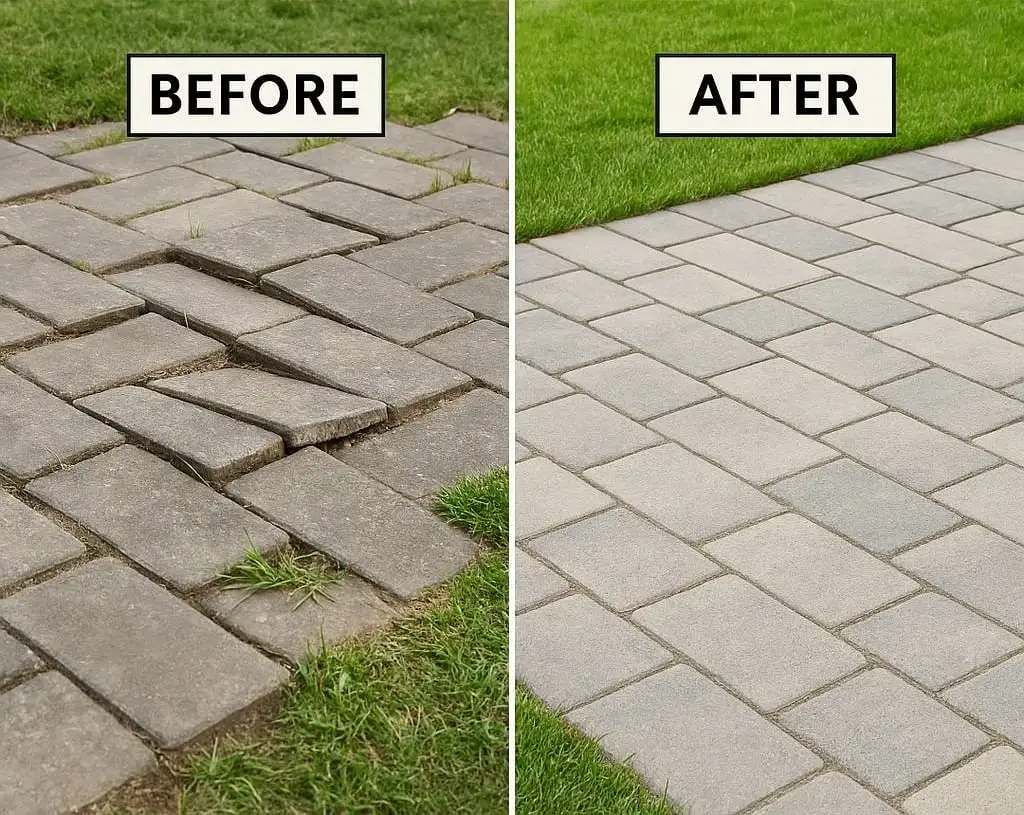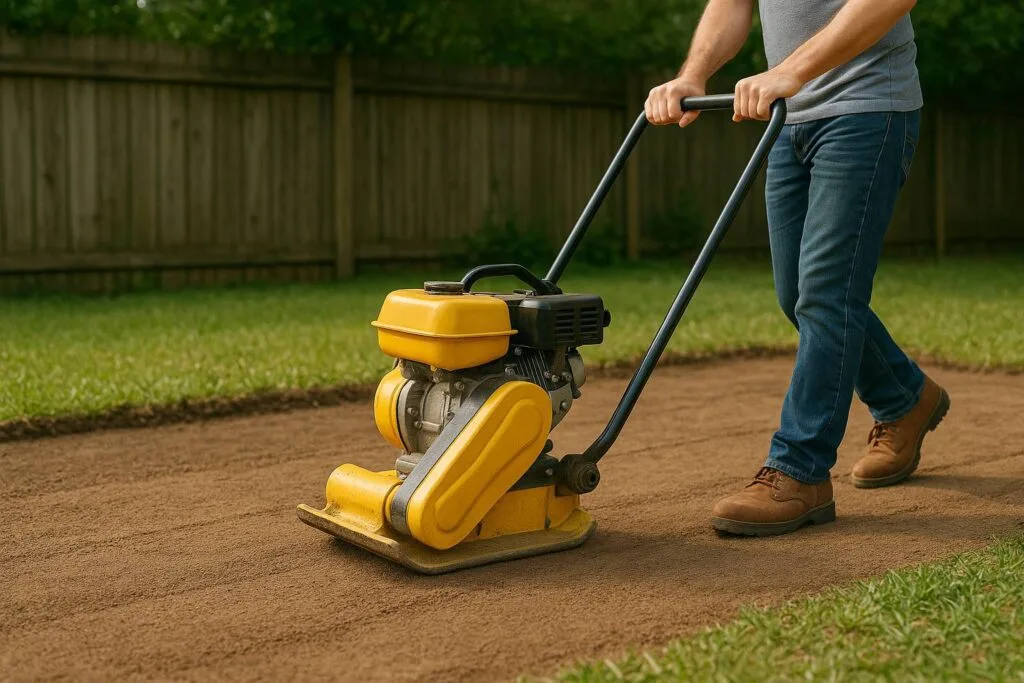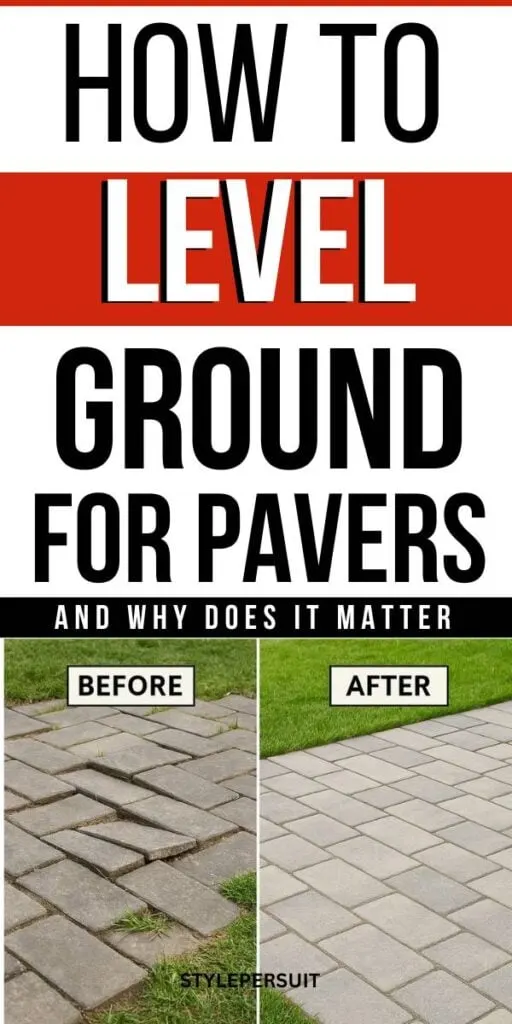You don’t need a landscaping degree to pull this off. But you do need a little patience, some decent tools, and the willingness to get your hands dirty.
Leveling ground for pavers sounds like one of those straightforward chores, dig, tamp, done. Right? Well… almost.
If you’ve ever walked on a patio that wobbles like a toddler’s tower of blocks, you already know what happens when the prep work gets rushed.
The truth is, most beautiful, long-lasting patios or walkways are built on the kind of groundwork nobody ever sees.
So if you’re dreaming of a clean, solid surface that doesn’t puddle, shift, or crack within a season or two, this is where it all begins.
So You Want Pavers? Let’s Talk About Why Leveling Matters

Let’s just be honest: it’s not the most thrilling part of the project. Nobody brags about how well they compacted the base layer.
But get it wrong, and you’ll be fixing things every year.
Leveling the ground properly gives your pavers a stable, even bed to rest on. Without that, they’ll sink, shift, or tilt over time, especially in areas with rain, freezing temps, or heavy foot traffic.
Water doesn’t drain right, weeds pop up through gaps, and before you know it, your “low maintenance” backyard upgrade feels like a full-time job.
Please think of this like baking a cake: you wouldn’t decorate it before it’s fully baked. Same goes for laying pavers, you want a solid, even base before you dress it up.
Tools You’ll Actually Use (and a Few You’ll Wish You Had)
Let’s keep it real: you can get by with a pretty basic setup. But there are a few tools that’ll make things way easier.
What you’ll need:
- Flat shovel or spade (for digging and cutting clean edges)
- Garden rake (metal, not plastic)
- Hand tamper (or a rented plate compactor if you want to save your shoulders)
- Stakes and string (for creating level reference lines)
- Level (a long spirit level or laser level works best)
- Tape measure
- Wheelbarrow (your best friend if you’re hauling gravel or sand)
- Screed board (you can DIY this with a straight 2×4)
Nice-to-haves:
- Plate compactor (rentable from most hardware stores)
- Landscape fabric (helps prevent weeds and keeps layers separated)
- Pickaxe (if your soil is tough or full of roots)
A little tip: don’t go wild buying everything brand new. Renting from a home improvement store for a day or two can save you a chunk of change.
Or ask around, your neighbor with the manicured yard might have a compactor sitting in the shed.
Scout the Area: Mark, Measure, and Mentally Prepare
Before you break ground, take a slow walk across the area. Notice any slopes? Tree roots? Utility boxes? Standing water after rain?
Mark your area with stakes and string lines to define the edges. Then use a line level or laser level to figure out your slope.
You want a slight pitch (about 1/4 inch per foot) away from your house or any structure to avoid drainage issues later.
And yeah, it’s worth repeating: drainage is non-negotiable. You don’t want to create a beautiful patio that turns into a pond every time it rains.
Quick tip: If you’re planning a small walkway or sitting area, you can use a garden hose laid out in the shape you want.
It’s surprisingly helpful for visualizing the layout before committing.
Removing the Top Layer: Grass, Weeds, and General Chaos
Time to dig. You’re aiming to remove all the grass, roots, and topsoil until you reach a stable layer.
This usually means 4–6 inches deep, but it depends on your paver thickness and what kind of base you’re installing.
Quick depth breakdown:
- 4–6 inches for the gravel base
- 1 inch for the bedding sand
- Thickness of your pavers (usually 2–3 inches)
That’s a total depth of roughly 7–10 inches. It sounds like a lot, but don’t skimp, this depth is what keeps things from shifting later.
Dig down evenly, and use your rake to pull soil out and smooth as you go. It doesn’t have to be perfect just yet, but aim for a generally flat surface.
Pro tip: dump the removed soil into your garden beds, or offer it up on Facebook Marketplace.
People will literally show up with buckets to take it off your hands.
Flattening the Earth Like You Mean It

Once you’ve cleared the top layer, it’s time to tamp things down. And here’s the trick, don’t skip this step, no matter how tempting it is to move on.
If you’re doing a small project, a hand tamper will do. But for a larger patio or anything over 100 square feet? Rent a plate compactor.
Your lower back will thank you.
Go over the area until the soil feels solid underfoot, no soft spots, no wiggly areas. If it still feels loose, mist it lightly with water and compact again.
The moisture helps it settle better.
Laying the Base: It’s Not Sexy, But It’s Vital
The base layer is usually made of crushed gravel or stone (called “paver base” or “crusher run”).
This material packs down tightly and allows for drainage, which is exactly what you want.
Here’s how to build the base:
- Add a 2-inch layer of gravel and rake it out evenly.
- Mist lightly with a hose.
- Compact it.
- Repeat until you’ve built up 4 to 6 inches total.
Yes, this takes time. Yes, it’s repetitive. But skipping these layers or compacting too fast leaves air pockets, aka future sunken pavers.
You can use your string lines and level to make sure you’re maintaining the slope as you go. Every couple of feet, stop and check.
Trust your eye, but confirm with the level.
Sand Time: The Part People Rush and Regret

Once your gravel base is set, it’s time for the bedding layer, about 1 inch of sharp sand (not playground sand). This is where your pavers will sit.
Here’s where a screed board and some DIY genius come in handy. Lay two metal pipes or 1-inch conduit on either side of your work area, then use a long, straight 2×4 to drag across the top and level out the sand.
When done right, it’s smooth like butter.
When you’re satisfied, don’t walk on the sand. Lay pavers directly onto it. Walking disrupts the level surface and makes little dips you can’t always see until it’s too late.
Check Yourself Before You Pave Yourself
Before you even think about laying that first paver, take a few minutes to double-check everything.
- Is your slope still consistent?
- Are there low or soft spots in the sand?
- Are your string lines still straight?
Take your level and run it across the bed in a few directions. Spot a dip? Add a bit of sand and re-screed.
Better now than when the pavers are halfway done.
Common Mistakes That Ruin a Good Weekend Project
Here’s a short list of things that can mess up your project faster than you think:
- Skipping compaction: Loose soil or gravel will shift once it rains.
- Too much sand: If your sand bed is more than an inch thick, pavers will sink.
- Not installing edge restraints: Without them, pavers slowly drift out of place.
- Ignoring slope: Flat patios hold water; sloped ones drain like a dream.
And the big one? Rushing. The prep work takes time. But the payoff is huge, literally, for years to come.
The Emotional Toll of DIY (and Why It’s Worth It Anyway)
Somewhere around the third hour of compacting gravel, you might start questioning your life choices. That’s normal.
Every backyard warrior hits a wall at some point.
But there’s something deeply satisfying about building something that’ll last. When your kids ride bikes across those pavers, or you’re sipping a cold drink on your new patio, the blisters and sore arms feel worth it.
Take breaks. Celebrate the little wins. And if you hit a spot that just isn’t working? Sleep on it. There’s no shame in pausing.
Wrapping It Up With Confidence
So, what do you walk away with? Hopefully not just sore legs. You’ve built the foundation, literally, for a patio, walkway, or sitting area that won’t budge with every season.
Final checklist:
- Excavated to proper depth?
- Compacted soil and base layer?
- Gravel is built in layers and compacted between each?
- Sand screeded evenly?
- Slope checked?
- Edge restraints ready?
Once the ground is prepped, the actual paver laying goes much faster. It’s like putting together a giant outdoor puzzle, except you already did the hard part.

